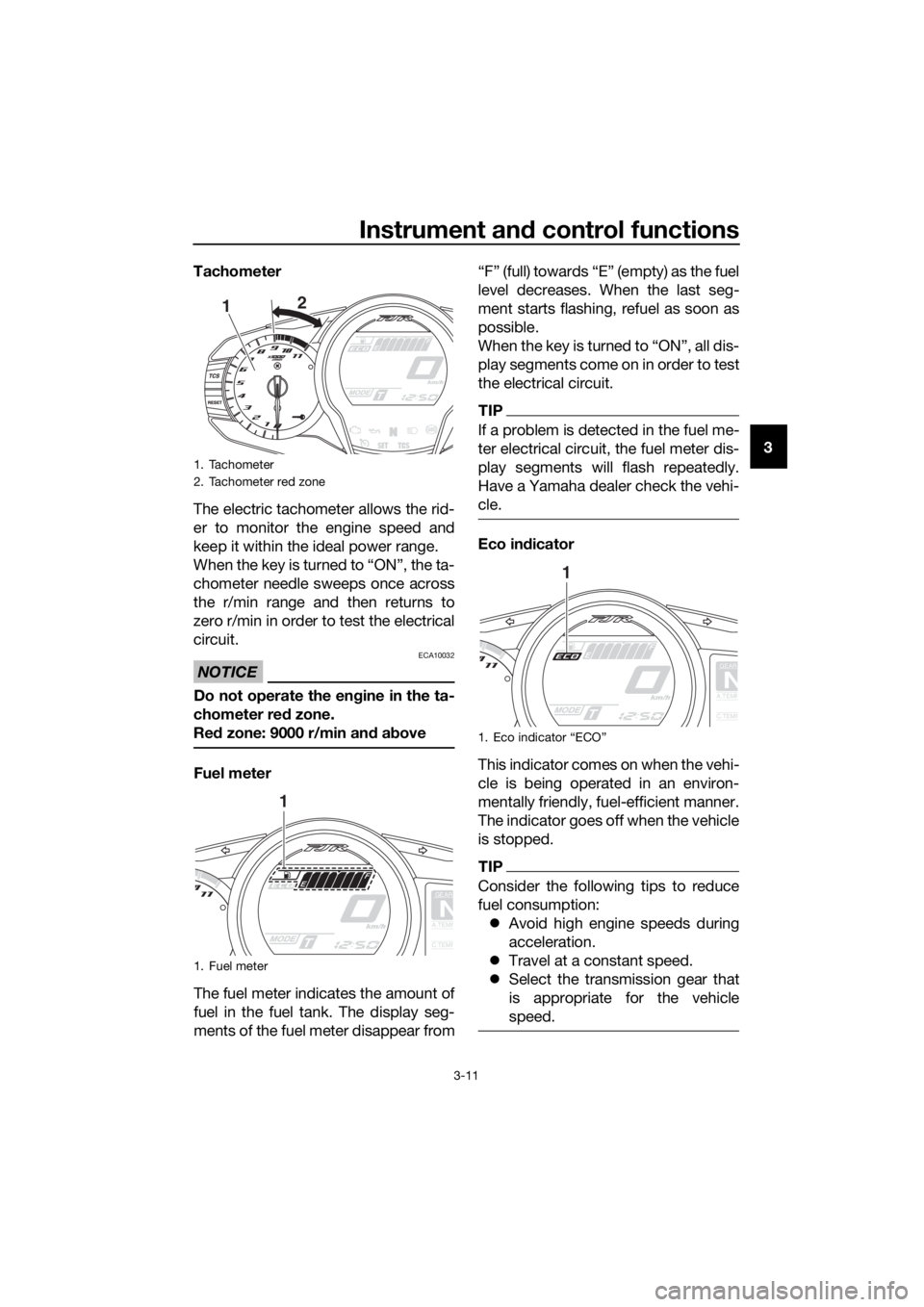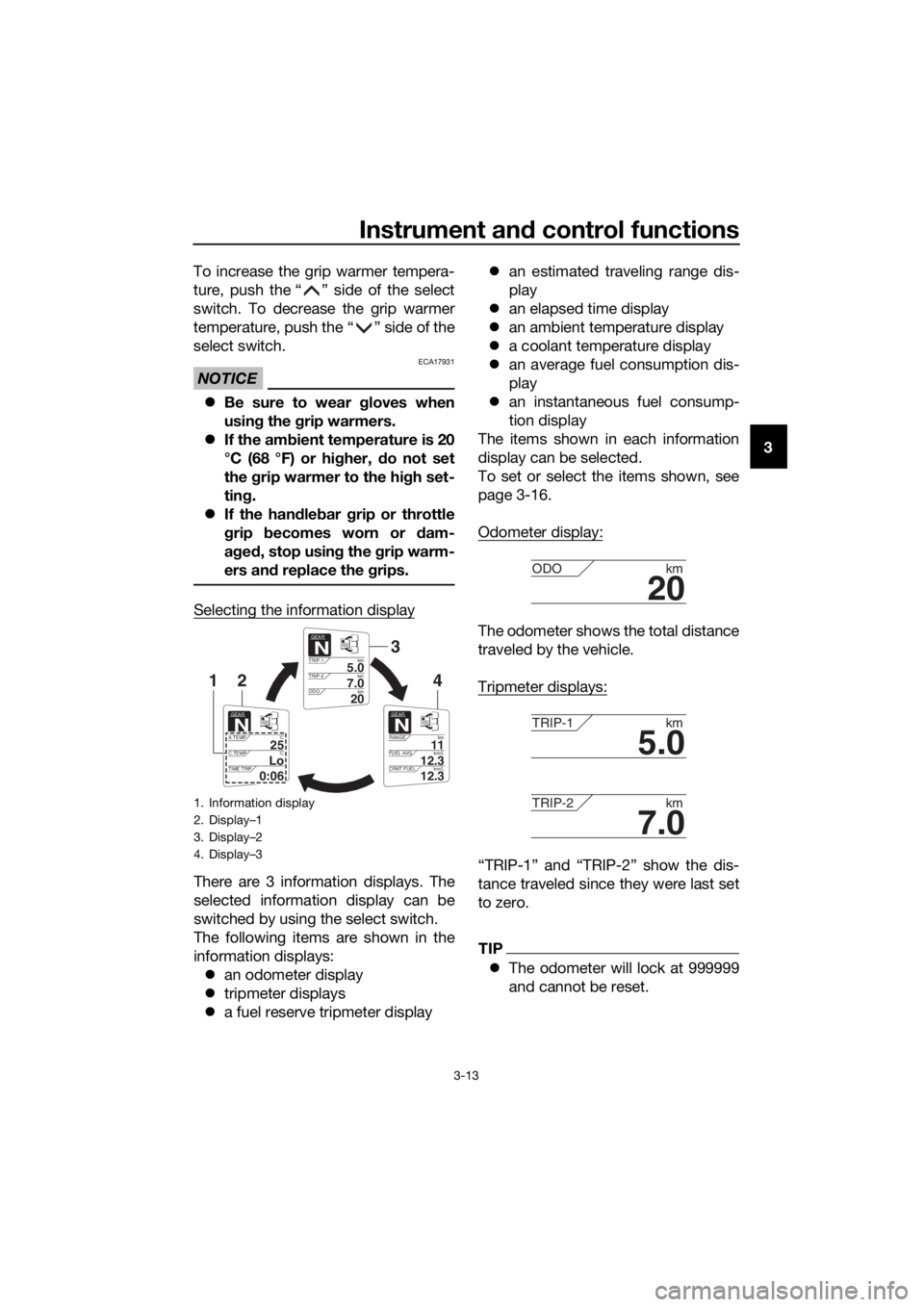fuel consumption YAMAHA FJR1300A 2016 Owners Manual
[x] Cancel search | Manufacturer: YAMAHA, Model Year: 2016, Model line: FJR1300A, Model: YAMAHA FJR1300A 2016Pages: 120, PDF Size: 3.41 MB
Page 5 of 120

Table of contents
Safety information ............................1-1
Description ........................................2-1
Left view ..........................................2-1
Right view........................................2-2
Controls and instruments ................2-3
Instrument an d control functions ....3-1
Immobilizer system .........................3-1
Main switch/steering lock ...............3-2
Indicator lights and warning lights ............................................3-4
Cruise control system .....................3-7
Multi-function meter unit ...............3-10
D-mode (drive mode) ....................3-22
Handlebar switches.......................3-22
Clutch lever ...................................3-24
Shift pedal .....................................3-24
Brake lever ....................................3-25
Brake pedal ...................................3-25
ABS ...............................................3-26
Traction control system.................3-27
Fuel tank cap.................................3-28
Fuel................................................3-29
Fuel tank overflow hose ................3-30
Catalytic converters .....................3-31
Seats .............................................3-31
Adjusting the rider seat height ......3-33
Storage compartments .................3-35
Accessory box...............................3-36
Adjusting the headlight beams......3-37
Handlebar position ........................3-37
Opening and closing the cowling vents ..........................................3-38
Rear view mirrors ..........................3-39
Adjusting the front fork..................3-40
Adjusting the shock absorber assembly....................................3-42
Sidestand ......................................3-43
Ignition circuit cut-off system........3-44
Auxiliary DC jack ...........................3-46 For your safety – pre-operation
checks
............................................... 4-1
Operation an d important ri din g
points ................................................. 5-1
Starting the engine.......................... 5-2
Shifting ............................................ 5-3
Tips for reducing fuel consumption................................ 5-4
Engine break-in ............................... 5-5
Parking ............................................ 5-6
Perio dic maintenance an d
a d justment ........................................ 6-1
Owner’s tool kit ............................... 6-2
Periodic maintenance chart for the emission control system.............. 6-3
General maintenance and lubrication chart........................... 6-4
Removing and installing panels ...... 6-7
Checking the spark plugs ............. 6-10
Canister......................................... 6-11
Engine oil and oil filter cartridge ... 6-11
Final gear oil.................................. 6-14
Coolant ......................................... 6-15
Cleaning the air filter element ....... 6-17
Checking the engine idling
speed......................................... 6-18
Checking the throttle grip free
play ............................................ 6-19
Valve clearance ............................. 6-19
Tires .............................................. 6-20
Cast wheels .................................. 6-22
Clutch lever ................................... 6-23
Checking the brake lever free play ............................................ 6-23
Brake light switches ...................... 6-24
Checking the front and rear brake pads........................................... 6-24
Checking the brake and clutch fluid levels .................................. 6-25
Changing the brake and clutch fluids .......................................... 6-27
Checking and lubricating the cables ........................................ 6-27
UB88E0E0.book Page 1 Friday, October 16, 2015 11:59 AM
Page 25 of 120

Instrument and control functions
3-11
3
Tachometer
The electric tachometer allows the rid-
er to monitor the engine speed and
keep it within the ideal power range.
When the key is turned to “ON”, the ta-
chometer needle sweeps once across
the r/min range and then returns to
zero r/min in order to test the electrical
circuit.
NOTICE
ECA10032
Do not operate the en
gine in the ta-
chometer red zone.
Re d zone: 9000 r/min an d a bove
Fuel meter
The fuel meter indicates the amount of
fuel in the fuel tank. The display seg-
ments of the fuel meter disappear from “F” (full) towards “E” (empty) as the fuel
level decreases. When the last seg-
ment starts flashing, refuel as soon as
possible.
When the key is turned to “ON”, all dis-
play segments come on in order to test
the electrical circuit.
TIP
If a problem is detected in the fuel me-
ter electrical circuit, the fuel meter dis-
play segments will flash repeatedly.
Have a Yamaha dealer check the vehi-
cle.
Eco in
dicator
This indicator comes on when the vehi-
cle is being operated in an environ-
mentally friendly, fuel-efficient manner.
The indicator goes off when the vehicle
is stopped.
TIP
Consider the following tips to reduce
fuel consumption: Avoid high engine speeds during
acceleration.
Travel at a constant speed.
Select the transmission gear that
is appropriate for the vehicle
speed.
1. Tachometer
2. Tachometer red zone
1. Fuel meter
1 2
GEAR
NA.TEMP
C.TEMP
1
1. Eco indicator “ECO”
GEAR
NA.TEMP
C.TEMP
1
UB88E0E0.book Page 11 Friday, October 16, 2015 11:59 AM
Page 27 of 120

Instrument and control functions
3-13
3
To increase the grip warmer tempera-
ture, push the “ ” side of the select
switch. To decrease the grip warmer
temperature, push the “ ” side of the
select switch.
NOTICE
ECA17931
Be sure to wear g loves when
usin g the grip warmers.
If the am bient temperature is 20
°C (68 °F) or hig her, do not set
the grip warmer to the hi gh set-
ting .
If the han dle bar grip or throttle
g rip becomes worn or dam-
a g ed , stop usin g the grip warm-
ers an d replace the grips.
Selecting the information display
There are 3 information displays. The
selected information display can be
switched by using the select switch.
The following items are shown in the
information displays:
an odometer display
tripmeter displays
a fuel reserve tripmeter display
an estimated traveling range dis-
play
an elapsed time display
an ambient temperature display
a coolant temperature display
an average fuel consumption dis-
play
an instantaneous fuel consump-
tion display
The items shown in each information
display can be selected.
To set or select the items shown, see
page 3-16.
Odometer display:
The odometer shows the total distance
traveled by the vehicle.
Tripmeter displays:
“TRIP-1” and “TRIP-2” show the dis-
tance traveled since they were last set
to zero.
TIP
The odometer will lock at 999999
and cannot be reset.
1. Information display
2. Display–1
3. Display–2
4. Display–3
GEARN
5.0TRIP-1 km
7.0TRIP-2km
km
20ODO
GEARN
11RANGEkm
12.3FUEL AVG km/L
km/L
12.3CRNT FUEL
GEARN
25A.TEMP ˚C
LoC.TEMP ˚C
0:06TIME TRIP
3
421
20
ODOkm
5.0
TRIP-1km
7.0
TRIP-2km
UB88E0E0.book Page 13 Friday, October 16, 2015 11:59 AM
Page 29 of 120

Instrument and control functions
3-15
3
TIP
–9 °C will be displayed even if the
ambient temperature falls below
–9 °C.
50 °C will be displayed even if the
ambient temperature climbs
above 50 °C.
The accuracy of the temperature
reading may be affected when rid-
ing under 20 km/h (12 mi/h) or
when stopped at traffic signals
and railroad crossings.
Coolant temperature display:
The coolant temperature display indi-
cates the temperature of the coolant.
The coolant temperature varies with
changes in the weather and engine
load.
If the message “Hi” flashes, stop the
vehicle, then stop the engine and let
the engine cool. (See page 6-38.)
TIP
The selected information display can-
not be switched while the message
“Hi” is flashing.
NOTICE
ECA10022
Do not continue to operate the en-
gine if it is overheating.
Average fuel consumption display:
The average fuel consumption display
modes “km/L”, “L/100km” or “MPG”
show the average fuel consumption
since the display was last reset.
The “km/L” display shows the av-
erage distance that can be trav-
eled on 1.0 L of fuel.
The “L/100km” display shows the
average amount of fuel necessary
to travel 100 km.
The “MPG” display shows the av-
erage distance that can be trav-
eled on 1.0 Imp.gal of fuel.
To reset the average fuel consumption
display, use the select switch to select
the information display that contains
the average fuel consumption display.
Push the “RESET” button briefly so
that the average fuel consumption dis-
play flashes, and then push the “RE-
SET” button again for 2 seconds while
the display is flashing.
TIP
After resetting the average fuel con-
sumption display, “_ _._” will be shown
for that display until the vehicle has
traveled 1 km (0.6 mi).
Lo
C.TEMP ˚C
GEAR
4
Hi
C.TEMP˚C
12.3
FUEL AVG km/L
UB88E0E0.book Page 15 Friday, October 16, 2015 1:59 PM
Page 30 of 120

Instrument and control functions
3-16
3
NOTICE
ECA15474
If there is a malfunction, “– –.–” will
b e continuously displaye d. Have a
Yamaha dealer check the vehicle.
Instantaneous fuel consumption dis-
play:
The instantaneous fuel consumption
display modes “km/L”, “L/100km” or
“MPG” show the fuel consumption un-
der the current riding conditions.
The “km/L” display shows the dis-
tance that can be traveled on 1.0 L
of fuel.
The “L/100km” display shows the
amount of fuel necessary to travel
100 km.
The “MPG” display shows the dis-
tance that can be traveled on
1.0 Imp.gal of fuel.
TIP
If traveling at speeds under 10 km/h (6
mi/h), “_ _._” will be displayed.
NOTICE
ECA15474
If there is a malfunction, “– –.–” will
be continuously displaye d. Have a
Yamaha dealer check the vehicle.
Settin g mo de
TIP
The transmission must be in neu-
tral and the vehicle must be
stopped to change settings in this
mode.
Shifting the transmission into gear
and starting off, or turning the key
to “OFF”, saves all settings made,
then exits the setting mode.
Push the “MENU” switch for 2 seconds
to enter the setting mode. To exit the
setting mode and return to the normal
display, push the “MENU” switch
again for at least 2 seconds.
12.3
CRNT FUEL km/L
1. Setting mode display
Display Description This function allows you to
set the low, middle, and
high settings to 10 tem-
perature levels.
This function allows you to
check and reset the “OIL”
oil change interval (dis-
tance traveled), and the
“FREE-1” and “FREE-2”
maintenance intervals.
MENUGrip WarmerMaintenanceTime TripUnitDisplayBrightnessClock
1
Grip Warmer
Maintenance
UB88E0E0.book Page 16 Friday, October 16, 2015 11:59 AM
Page 66 of 120

Operation and important rid ing points
5-4
5 clutch lever in, use the brakes to
slow the motorcycle, and continue
to downshift as necessary.
4. Once the motorcycle has stopped, the transmission can be
shifted into the neutral position.
The neutral indicator light should
come on and then the clutch lever
can be released.
WARNING
EWA17380
Improper brakin g can cause
loss of control or traction. Al-
ways use b oth brakes an d apply
them smoothly.
Make sure that the motorcycle
and the en gine have sufficiently
slowe d b efore shiftin g to a low-
er gear. En gag in g a lower gear
when the vehicle or en gine
speed is too hi gh coul d make
the rear wheel lose traction or
the en gine to over-rev. This
coul d cause loss of control, an
acci dent an d injury. It coul d also
cause en gine or drive train dam-
a g e.
EAU64150Recommen ded shift points
The recommended shift points during
acceleration and deceleration are
shown in the table below.
EAU16811
Tips for re ducin g fuel con-
sumption
Fuel consumption depends largely on
your riding style. Consider the follow-
ing tips to reduce fuel consumption:
Shift up swiftly, and avoid high en-
gine speeds during acceleration.
Do not rev the engine while shift-
ing down, and avoid high engine
speeds with no load on the en-
gine.
Turn the engine off instead of let-
ting it idle for an extended length
of time (e.g., in traffic jams, at traf-
fic lights or at railroad crossings).
Shift up points:
1st → 2nd: 20 km/h (12 mph)
2nd → 3rd: 30 km/h (19 mph)
3rd → 4th: 40 km/h (25 mph)
4th → 5th: 50 km/h (31 mph)
5th → 6th: 60 km/h (37 mph)
Shift down points:
6th → 5th: 45 km/h (28 mph)
5th → 4th: 35 km/h (22 mph)
4th → 3rd: 25 km/h (16 mph)
UB88E0E0.book Page 4 Friday, October 16, 2015 11:59 AM
Page 117 of 120

10-1
10
Index
A
ABS ...................................................... 3-26
ABS warning light ................................... 3-5
Accessory box...................................... 3-36
Air filter element, cleaning .................... 6-17
Auxiliary DC jack .................................. 3-46
B
Battery .................................................. 6-32
Brake and clutch fluid levels,
checking............................................. 6-25
Brake and clutch fluids, changing ........ 6-27
Brake and clutch levers, checking
and lubricating ................................... 6-29
Brake and shift pedals, checking and
lubricating .......................................... 6-28
Brake lever ........................................... 3-25
Brake lever free play, checking ............ 6-23
Brake light switches ............................. 6-24
Brake pedal .......................................... 3-25
C
Cables, checking and lubricating ......... 6-27
Canister ................................................ 6-11
Care ........................................................ 7-1
Catalytic converters ............................. 3-31
Centerstand and sidestand, checking
and lubricating ................................... 6-29
Clutch lever ................................. 3-24, 6-23
Coolant ................................................. 6-15
Cowling vents, opening and closing .... 3-38
Cruise control indicator lights ................ 3-4
Cruise control switches ........................ 3-23
Cruise control system ............................ 3-7
D
Diagnostic connector ............................. 9-2
Dimmer/Pass switch ............................ 3-22
D-mode (drive mode) ........................... 3-22
E
Engine break-in ...................................... 5-5
Engine idling speed, checking ............. 6-18
Engine oil and oil filter cartridge ........... 6-11
Engine serial number.............................. 9-1
Engine trouble warning light................... 3-5
F
Final gear oil ......................................... 6-14
Front and rear brake pads, checking ... 6-24
Front fork, adjusting ............................. 3-40
Front fork, checking ............................. 6-31
Fuel....................................................... 3-29
Fuel consumption, tips for reducing ...... 5-4
Fuel tank cap........................................ 3-28 Fuel tank overflow hose ........................ 3-30
Fuses, replacing.................................... 6-34
H
Handlebar position, adjusting ............... 3-37
Handlebar switches .............................. 3-22
Hazard switch ....................................... 3-23
Headlight beams, adjusting .................. 3-37
High beam indicator light........................ 3-4
Horn switch........................................... 3-23
I
Identification numbers ............................ 9-1
Ignition circuit cut-off system ............... 3-44
Immobilizer system ................................. 3-1
Immobilizer system indicator light .......... 3-6
Indicator lights and warning lights .......... 3-4
M
Main switch/steering lock ....................... 3-2
Maintenance and lubrication, periodic ... 6-4
Maintenance, emission control
system .................................................. 6-3
Matte color, caution ................................ 7-1
Menu switch ......................................... 3-23
Model label ............................................. 9-1
Multi-function meter unit ...................... 3-10
N
Neutral indicator light.............................. 3-4
O
Oil level warning light .............................. 3-4
P
Panels, removing and installing .............. 6-7
Parking .................................................... 5-6
Part locations .......................................... 2-1
R
Rear suspension, lubricating ................ 6-30
Rear view mirrors .................................. 3-39
Rider seat height, adjusting .................. 3-33
S
Safety information................................... 1-1
Seats ..................................................... 3-31
Select switch ........................................ 3-23
Shifting .................................................... 5-3
Shift pedal............................................. 3-24
Shock absorber assembly, adjusting ... 3-42
Sidestand .............................................. 3-43
Spark plugs, checking .......................... 6-10
Specifications ......................................... 8-1
Starting the engine.................................. 5-2
Steering, checking ................................ 6-31
Stop/Run/Start switch .......................... 3-23
Storage ................................................... 7-4
UB88E0E0.book Page 1 Friday, October 16, 2015 11:59 AM